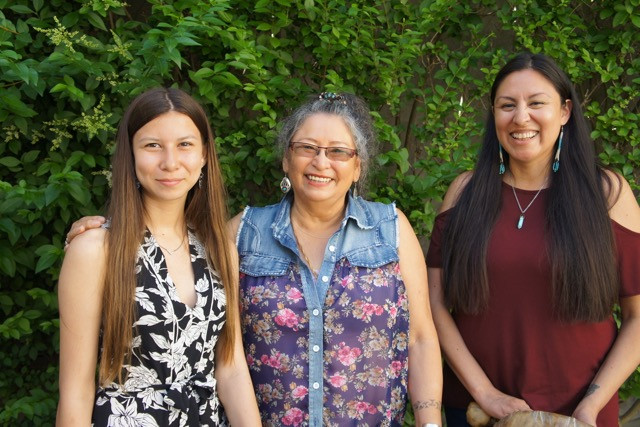A First Nation of Cree, Ojibway and Scottish descent, now 69, she wants to share that cultural knowledge with future generations. This, she says, is the only way to heal the damage done to her people’s way of life, damage which has led to the murder and disappearance of an estimated 4,000 indigenous women in Canada.
“For me, it dawned on me in 1985 that I lived like a non-native person. I didn’t know my language, culture or any practices,” she says, recalling she cried when the realisation hit. Her parents had not taught her their cultures, she presumes so that she and her siblings would fit in at the local public school.
“Left for dead”
Kay’s parents wanted to protect her because as a First Nations woman she was particularly vulnerable, something they learned the hard way. When Kay was just eight, her mother was assaulted by a miner living the area and “left for dead” in the bush, an attack she survived but for which no-one was ever charged because of prejudice. “There’s lots of stories we can tell about that,” Kay sighs, falling silent.
Her father knew some of his people’s cultural practices when he was young, but he was sent to a residential school, part of the system of ethnic cleansing in which some 150,000 First Nation children were forcibly removed from their parents from 1831 and 1996.
“They weren’t allowed to speak their language, their hair was cut so, even when they did go home in the summertime, they couldn’t even communicate with their parents anymore because they didn’t know their language. That’s one way they broke down the family system,” Kay says.
She believes that most of the problems First Nations people face today stem from the residential school system, in which abuse was rife, they were taught to feel ashamed of their culture and which destroyed the matriarchal social structures they had grown up with.
“They didn’t know how to parent because they left the care system at the age of 18,” Heather Lewis, a jingle dancer and model who accompanied Kay to Luxembourg, says, adding that many fall into a cycle of substance abuse, placing First Nations people at high risk yet low priority for public authorities.
Cultural genocide
A recent public inquiry into the deaths and disappearances of indigenous women was one of Justin Trudeau’s first acts after becoming prime minister in 2015. The four-year investigation into Missing and Murdered Indigenous Women and Girls heard from 2,380 family members and survivors.
The final report, Reclaiming Power and Place, published at the beginning of June 2019, found that the real rate of missing and murdered was around four times higher than the rate recorded by the Royal Canadian Mounted Police. What is more for the first time, it concluded that these incidents were part of a cultural genocide.
Kay’s own awareness-raising work precedes the report by some 20 years. Kay’s grandmother taught her to sew by hand and then using a treadle machine. She made her own clothes as a teenager and then switched to making regalia and clothing with First Nations symbols in the 1990s.

From left: Heather Lewis, Lyn Kay Peters and Kaitlin Peters. Photo: Jess Bauldry
Today, the stories of the missing and murdered indigenous women are deeply woven into her designs, appearing in, among other things, a tipi dress with figures of missing women, which her grand-daughter, Kaitlin, will model in a fashion show in Luxembourg on Wednesday.
“It’s what makes me proud, sharing our culture,” she says. Kay made a white buckskin, which was worn by Ashley Burnham, an Enoch Cree Nation, who became the first First Nations woman to win the title of Mrs Universe in 2015.
Resilient people
Clearly, things are changing. Kay beams with pride as she describes the revival of First Nations culture. And they are seizing the tools to become architects of change, finishing school, and working for public authorities. One of her nieces even graduated with a Masters in native linguistics. “I think we are making headways, even as much as the atrocities we went through as First Nations people, I think we’re resilient people. We’ve come a long way and we’re going to continue going a long way,” she says.
Kay too has worked at herself. After separating from her husband, she has continuously studied her culture and has done a lot of work on aboriginal health for the Bird Island, a BC-based reserve which has its own healthcare, schools and recovery homes. Kay serves as a council member for her band, a role which she expects to step down from next year but not so that she can retire. “I want to teach everything I’ve learned over the course of my life. I’ve a lot of knowledge and I want to pass it on,” she smiles.
Meet Kay in Luxembourg
You can meet Kay, Heather and Kaitlin in Luxembourg on Wednesday 26 June at the Rotondes from 6:30pm at “Finding the Patterns, Indigenous Women of Canada”. Organised jointly with Time for Equality, this event includes dance, a talk and a fashion show of Kay’s designs.
The three will also speak at Citim, 55 avenue de la Liberté, L-1931, Luxembourg-Gare, at 12:15 on Friday, 28 June. More information here.
Why wear red to these events?
The red dress has come to symbolise awareness of missing and murdered indigenous women as well as men. It is considered a way to “red-dress” the situation. People participating in these events in Luxembourg can therefore wear red or a red dress in to show their solidarity.
